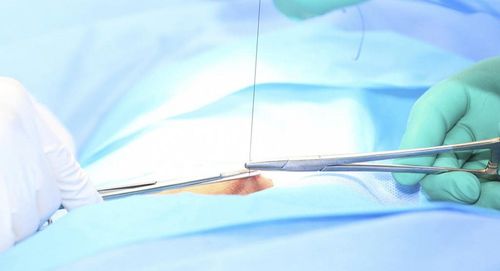This is an automatically translated article.
The article was professionally consulted by MSc, Dr. Trinh Thi Thanh Huyen - Obstetrician and Gynecologist - Department of Obstetrics and Gynecology - Vinmec Hai Phong International General HospitalPostpartum bleeding is a common obstetric complication, all women are at risk of postpartum blood loss because more than 40% of cases have no identifiable cause. When postpartum blood loss occurs, it must be treated aggressively as an obstetric emergency. Uterine artery ligation is a surgery that can be used if medical intervention is not effective.
1. When is the surgery indicated for uterine artery ligation?
Postpartum blood loss is an obstetric emergency, this is one of the five most dangerous obstetric complications, if not promptly intervened, the mother will have a high risk of death. The medical measures to treat postpartum blood loss are injection of uterotonics, uterine massage, use of a balloon to insert the uterine lumen, etc. If these treatments fail, surgical treatment will be switched.
Uterine artery ligation or (uterine artery embolization) surgery is a surgical procedure performed quite commonly, to help block blood flow in the uterine artery, thereby reducing blood flow to the uterus.
Uterine artery ligation, if performed well, can reduce blood flow to the uterus by up to 40%, and the success rate of surgery can be up to 99%. Uterine artery ligation is indicated in cases of postpartum blood loss due to uterine atony, bleeding in the placenta previa or bleeding in the uterine cavity due to other causes.

Lượng máu tới tử cung sẽ giảm tới 40% khi thắt động mạch tử cung
2. How is uterine artery knotting surgery performed?
2.1 Preparation steps
The trained obstetrician and surgical team will wash their hands before surgery according to the procedures of the Ministry of Health, wear surgical uniforms, masks and sterile gloves.
Prepare secondary surgical instruments (which have been guaranteed to be sterile), necessary consumables such as cotton, gauze, targets, sewing needles,...
Before surgery, the patient will be Medical staff advise the purpose and possible complications during surgery. The steps to prepare the patient (preoperative hygiene, prophylactic antibiotic injection, test results, organ function assessment, ...) are performed as an obstetric emergency.
2.2 Steps to take
Stage 1: Open the lower peritoneum with a transverse incision in the lower segment. If uterine artery ligation is performed immediately after cesarean section, the lower transverse incision should be used for cesarean section. Stage 2: Perform anterior and posterior peritoneal dissection, and expose the uterine artery at the position where the artery changes direction from the base of the broad ligament to the side of the uterus. Stage 3: Performing uterine artery ligation: Using perlon thread, threaded through the uterine artery that was revealed in phase 2, ligation of the uterine arteries on the left and right sides. If the case is pregnant, a needle can be inserted through the inferior surface of the pedicle to remove the uterine muscle tissue and tie. Uterine artery ligation by suturing the entire arterial tissue. Stage 4: Suture the peritoneum and then continue to ligate the opposite artery. The advantages of uterine artery ligation are simple, easy to perform, fast (within 10 to 15 minutes), convenient because it can be performed right in the delivery room, less invasive to the patient. patient and high efficiency. The disadvantage of the method is that it is highly dependent on the experience of the surgeon.
3. Possible complications after uterine artery ligation surgery

Một trong những tai biến thường gặp ở phẫu thuật thắt động mạch tử cung là thắt vào niệu quản
Ureteral ligation: It can happen when the uterine artery is lied at a low position. . This case requires re-operation and removal for the patient. Hematoma: When the needle is inserted into the vessel, if the leaves of the broad ligament are not dissected to expose the uterine artery, hematoma is very likely to occur. Clamps are needed to block the blood vessels below the broad ligament to prevent the hematoma from spreading to the perineum and uterine wall. Failure to control bleeding: If this occurs, switching to other methods or having a hysterectomy may be considered in cases where rapid bleeding control is needed to prevent death.
Please dial HOTLINE for more information or register for an appointment HERE. Download MyVinmec app to make appointments faster and to manage your bookings easily.













